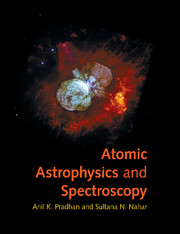Book contents
- Frontmatter
- Contents
- Preface
- Acknowledgements
- 1 Introduction
- 2 Atomic structure
- 3 Atomic processes
- 4 Radiative transitions
- 5 Electron–ion collisions
- 6 Photoionization
- 7 Electron–ion recombination
- 8 Multi-wavelength emission spectra
- 9 Absorption lines and radiative transfer
- 10 Stellar properties and spectra
- 11 Opacity and radiative forces
- 12 Gaseous nebulae and H II regions
- 13 Active galactic nuclei and quasars
- 14 Cosmology
- Appendix A Periodic table
- Appendix B Physical constants
- Appendix C Angular algebra and generalized radiative transitions
- Appendix D Coefficients of the fine structure components of an LS multiplet
- Appendix E Effective collision strengths and A-values
- References
- Index
8 - Multi-wavelength emission spectra
Published online by Cambridge University Press: 05 June 2012
- Frontmatter
- Contents
- Preface
- Acknowledgements
- 1 Introduction
- 2 Atomic structure
- 3 Atomic processes
- 4 Radiative transitions
- 5 Electron–ion collisions
- 6 Photoionization
- 7 Electron–ion recombination
- 8 Multi-wavelength emission spectra
- 9 Absorption lines and radiative transfer
- 10 Stellar properties and spectra
- 11 Opacity and radiative forces
- 12 Gaseous nebulae and H II regions
- 13 Active galactic nuclei and quasars
- 14 Cosmology
- Appendix A Periodic table
- Appendix B Physical constants
- Appendix C Angular algebra and generalized radiative transitions
- Appendix D Coefficients of the fine structure components of an LS multiplet
- Appendix E Effective collision strengths and A-values
- References
- Index
Summary
The origin of spectral lines depends on the matter and radiation fields that characterize the physical conditions in the source. However, the lines actually observed also depend on the intervening medium towards the observer. The wide variety of astrophysical sources span all possible conditions, and their study requires both appropriate modelling and necessary atomic parameters. The models must describe the extremes of temperature, density and radiation encountered in various sources, from very low densities and temperatures in interstellar and intergalactic media, to the opposite extremes in stellar interiors and other environments. As such, no single approximation can deal with the necessary physics under all conditions. Different methods have therefore been developed to describe spectral formation according to the particular object, and the range of physical conditions under consideration.
This is the first chapter devoted mainly to astrophysical applications. The theoretical formulation of atomic spectroscopy described hitherto is now applied to the analysis of emission-line observations in three widely disparate regions of the electromagnetic spectrum: the visible, X-ray and far-IR. Examples include some of the most well-known and widely used lines and line ratios. Emission line analysis depends on accurate calculations of emissivities, which, in turn, are derived from fundamental parameters such as collision strengths for (e + ion) excitation and recombination, and radiative transition probabilities. However, spectral models in complicated situations, such as line formation in transient plasmas and in the presence of external radiation fields, assume a level of complexity that requires consideration of a variety of processes and parameters.
- Type
- Chapter
- Information
- Atomic Astrophysics and Spectroscopy , pp. 175 - 193Publisher: Cambridge University PressPrint publication year: 2011



